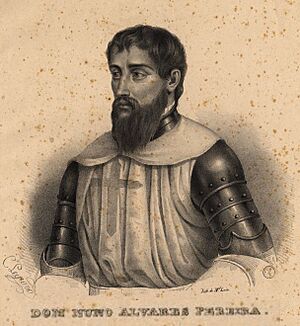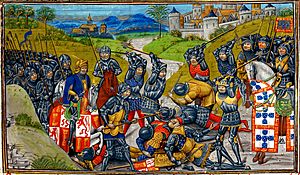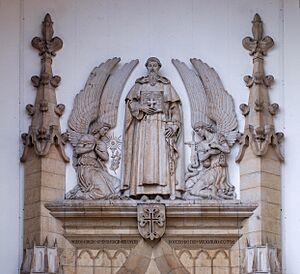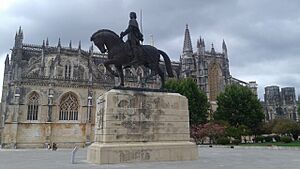Nuno Álvares Pereira facts for kids
Quick facts for kids
Nuno Álvares Pereira
|
|
|---|---|
 |
|
| Constable of Portugal | |
| Count of Barcelos, Ourém, and Arraiolos | |
| In office 6 April 1385 – 1 November 1431 |
|
| Monarch | John I of Portugal |
| Preceded by | Álvaro Pires de Castro |
| Succeeded by | John of Portugal |
| Lord High Steward | |
| In office 6 April 1385 – 1 November 1431 |
|
| Monarch | John I of Portugal |
| Preceded by | Garcia Rodrigues de Taborda |
| Succeeded by | Diogo Lopes de Sousa |
| Personal details | |
| Born | 24 June 1360 Cernache de Bonjardim, Portugal |
| Died | 1 November 1431 (aged 71) Convent of the Carmelites, Lisbon, Portugal |
| Saint Nuno of Saint Mary OCarm |
|
|---|---|
 |
|
| Venerated in | Catholic Church |
| Beatified | 23 January 1918, Vatican City by Pope Benedict XV |
| Canonized | 26 April 2009, Vatican City by Pope Benedict XVI |
| Major shrine | Church of Santa Engrácia |
| Feast | 6 November |
| Attributes | Knight, sword, fleur-de-lis, Carmelite habit |
Nuno Álvares Pereira was a very important Portuguese general. He lived from 1360 to 1431. He played a huge role in helping Portugal stay independent from Castile, a neighboring kingdom.
Later in his life, Nuno became a Carmelite friar. He is now known as a saint in the Catholic Church. People often call him the Saint Constable or Saint Nuno of Saint Mary. He also held important titles like Count of Barcelos, Ourém, and Arraiolos.
Contents
Early Life and Family
Nuno Álvares Pereira was born on June 24, 1360, in Cernache do Bonjardim, Portugal. His father was Dom Álvaro Gonçalves Pereira.
When Nuno was about one year old, a royal decree made him a legitimate son. This meant he could get the special education given to children of noble families. He learned how to be a knight.
At age 13, he became a page for Queen Leonor. When he was 16, he married Leonor de Alvim, a wealthy widow. They had three children. Sadly, two boys died young. Their daughter, Beatriz, married Afonso. Afonso was the son of King John I and started the important House of Aviz royal family.
Military Career
Nuno Álvares Pereira started his military service in 1373, when he was just 13 years old. He helped defend Portugal from an invasion by Castile. Even at a young age, he showed great bravery and leadership skills.
Portugal's Fight for Independence
In 1383, King Ferdinand I of Portugal died. His only heir was his daughter, Beatrice, who was married to King John I of Castile. Many Portuguese nobles wanted to keep Portugal independent. They supported John, Master of Aviz, King Ferdinand's half-brother, to become the new king.
After Nuno won his first big battle against the Castilians in April 1384, at the Battle of Atoleiros, John of Aviz gave him a very important job. Nuno became the Constable of Portugal. This meant he was the supreme commander of all Portugal's armies. He was only 24 years old.
Key Battles and Victories
In 1384, the Castilian army surrounded Lisbon, Portugal's capital. Nuno used clever tactics to fight them. Eventually, a plague forced the Castilians to leave.
In April 1385, John of Aviz was officially recognized as king by the Portuguese parliament. This made King John I of Castile invade Portugal again. He wanted his wife, Beatrice, to be queen. Nuno Álvares Pereira fought against cities that supported Castile. Even during the war, he helped feed people in the areas he was fighting against.
On August 14, 1385, Nuno led about 6,500 Portuguese volunteers at the Battle of Aljubarrota. They faced a much larger Castilian army of over 30,000 soldiers. Nuno and his army won a huge victory. This battle finally ended the threat of Castile taking over Portugal.
Nuno believed the victory was thanks to the Blessed Virgin Mary. He had her name, Maria, written on his sword. He was very devoted to Mary, fasting often. His personal flag showed a cross, Mary, and the saints James and George. He also used his own money to build many churches and monasteries.
After the war, Nuno received more important titles. He became the count of Arraiolos and Barcelos. He also became the main majordomo of the kingdom.
Nuno and King John I continued to attack Castilian towns. They won another battle at Valverde. Nuno kept a close watch on the King of Castile until he died in 1390. When the fighting stopped, Nuno gave most of his wealth to the soldiers who had fought with him.
Later Life and Sainthood
After his wife died, Nuno Álvares Pereira decided to become a Carmelite friar. He joined the order in 1423 at the Carmo Convent (Lisbon) in Lisbon. He had founded this convent himself, as he had promised to do. He took the name Friar Nuno of Saint Mary.
He lived at the convent until his death on November 1, 1431. He was known for his deep prayers and his strong devotion to the Mother of God. Nuno also suffered from a painful condition called arthritis.
In his last year, King John I visited him. The king cried, seeing Nuno as his closest friend. He knew Nuno had helped him become king and saved Portugal's independence.
Nuno Álvares Pereira's tomb was lost in the great 1755 Lisbon earthquake. His tombstone had a special message:
"Here lies that famous Nuno, the Constable, founder of the House of Bragança, excellent general, blessed monk, who during his life on earth so ardently desired the Kingdom of Heaven that after his death, he merited the eternal company of the Saints. His worldly honors were countless, but he turned his back on them. He was a great Prince, but he made himself a humble monk. He founded, built and endowed this church in which his body rests."
Becoming a Saint
Nuno Álvares Pereira was declared "Blessed" (a step towards sainthood) on January 23, 1918, by Pope Benedict XV.
On July 3, 2008, Pope Benedict XVI signed decrees that recognized Nuno's heroic virtues and a miracle linked to him. This meant he could become a saint. His official ceremony to become a saint took place on April 26, 2009, at Saint Peter's Square in the Vatican City. The Carmelites now celebrate Saint Nuno on November 6.
See also
 In Spanish: Nuno Álvares Pereira para niños
In Spanish: Nuno Álvares Pereira para niños
- Saint Nuno Álvares Pereira, patron saint archive





